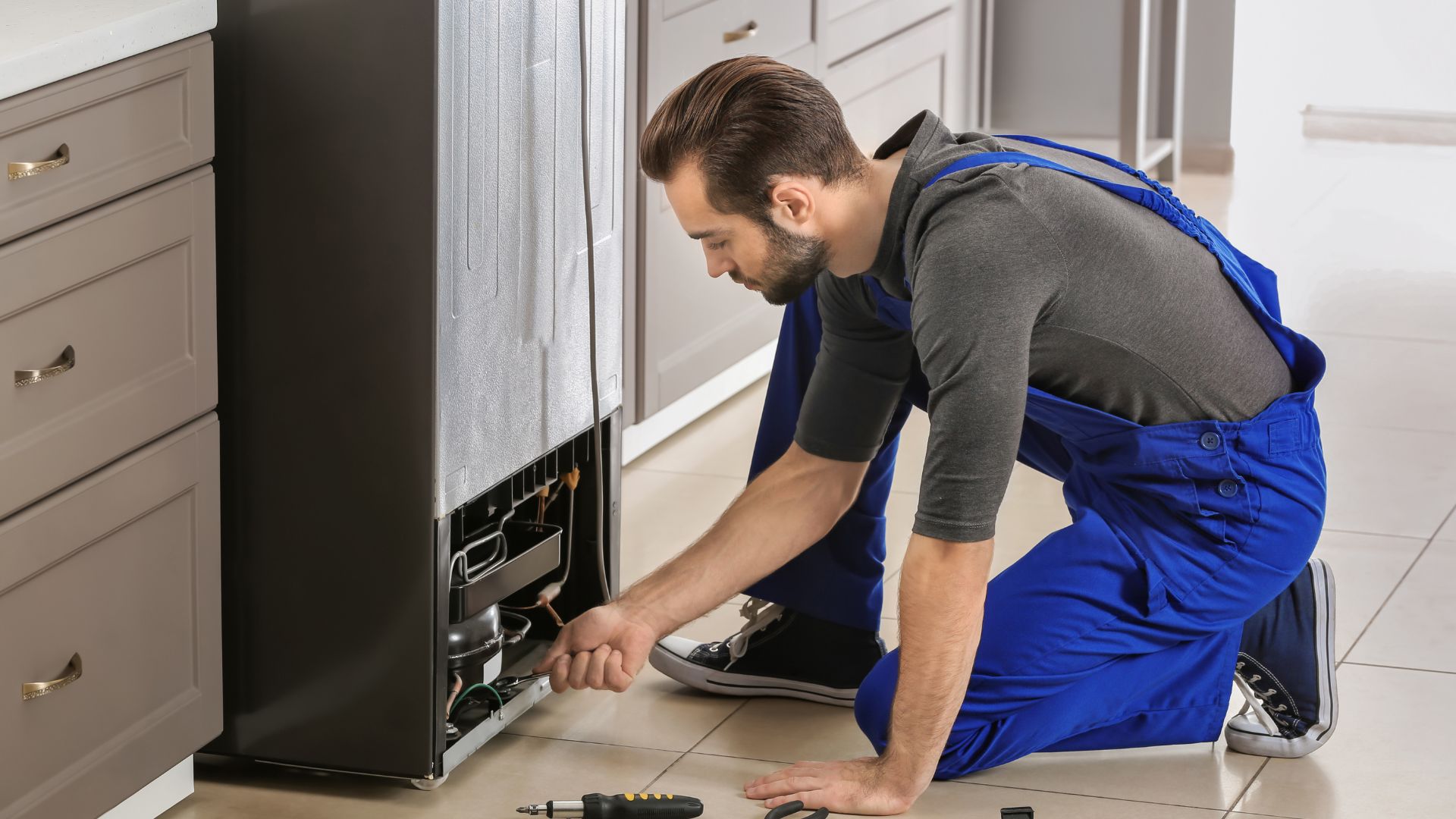The compressor works with the condenser and evaporator to circulate refrigerant. A Hisense fridge with a defective compressor cannot keep your food cool.
To troubleshoot the compressor, start by unplugging the Hisense fridge and pulling it away from the wall. Use the manual to identify the compressor’s location. Remove the screws holding the panel hiding the compressor. Inspect the compressor’s various components, including:
- External Protector
You will find the first protector on the common tab and the second on the compressor’s shell. One protector will open the circuit to the common tab when it detects high heat or current for an extended duration. The other protector opens the circuit to the compressor if it fails to start.
The goal is to keep the windings from melting. Inspect these components. Do you see burn marks or significant wear and tear?
- PTC Thermistor
The pill-type thermistor interrupts the circuit to the start tab. It activates when the compressor attains the appropriate speed. The thermistor must cool before it can work to start the compressor again.
- Starting Relay
The current starting relay, which you find on the run and start tabs, breaks the circuit to the start tab once the compressor attains the appropriate speed. It will reset immediately.
- Start Capacitor
This component allows a 90-degree phase shift in the power feeding the start tab.
- Time Starting Device
Check the start capacitor on the external compressor protector (on the inside of the time-starting device).
Naturally, most laypeople can’t inspect these components for damage because they don’t know what to look for. AC Service Tech LLC has pictures of all these parts and more and the best way to test them.
But you can stop testing the compressor with a multimeter. Compressors can fail for various reasons, including the following:
1). High Temperature
Compressors are hot. The temperature at the compressor discharge port can be as high as 300 degrees F. Nonetheless, a compressor can stop working because of overheating. Some people create these cases of overheating by placing their Hisense fridge in hot corners of their homes where the ventilation is poor.
2). Contaminants
Oil can leak because of a defect in the oil pump. This allows the oil to invade locations where it doesn’t belong. Oil leaks are difficult to diagnose, especially if the oil pump is not the culprit. However, oil is not your only concern. Compressors are just as vulnerable to moisture and dirt.
Moisture sounds harmless, but it can attract rust, compromising the compressor’s functions.
3). Run Out Of Refrigerant
All fridges run out of refrigerant after a while. However, refrigerant can also leak. This is a problem because insufficient refrigerant forces the compressor to burn out because it must work harder to pump the refrigerant through the appliance.
4). Failed Thermostat
The compressor doesn’t work alone. You have a thermostat that signals the start capacitor. The capacitor activates the compressor, which initiates the refrigeration cycle. What happens when the thermostat fails?
The compressor won’t start. The same problem arises when the capacitor malfunctions.
5). Dirty Condenser Coils
The condenser coils are vulnerable to contaminants. Dust, hair, and various forms of debris can cover them. If you forget to clean them, they will compromise the fridge’s operations by forcing the compressor to work harder than usual to generate cold air. Over time, the compressor will burn out.
6). Surge
Surges and spikes can destroy every sensitive component in the fridge, including the compressor and start relay. Surges can originate from lightning strikes, grid malfunctions, and the operations of heavy-duty appliances within your home as they cycle on and off.
7). Defective Control Board
Sophisticated fridges have a control board that runs everything, including the compressor. The compressor may stop working once the control board fails.
8). Age
Refrigerators have an average lifespan of ten to twenty years. As the fridge ages, its components wear out. Don’t be surprised if a compressor in a 10-year-old Hisense fridge fails. These components cannot last forever. Eventually, they will fail, forcing you to find a replacement.
Signs Of A Failing Hisense Fridge Compressor

1). The compressor produces a faint humming. Sometimes, that humming is intermittent. It will come and go. However, it shouldn’t disappear completely. If the sound stops permanently, the compressor is defective.
2). If that humming is not only constant but louder than usual, the compressor has failed. Sometimes, this sound is so loud that you can’t ignore it. But some people tolerate it for weeks and months, only taking steps to troubleshoot the component when the fridge stops working.
3). If you hear knocking instead of humming or buzzing, the compressor motor is loose.
4). A compressor with a defective start relay will struggle noticeably. It will only work half of the time. And even when it runs, the refrigerator is never as cool as you would like. Don’t be surprised if the compressor repeatedly switches on and off.
5). Compressors are hot. However, there is a limit to the amount of heat their operations generate. If the compressor’s temperature has exceeded 300 degrees F, you have a problem.
6). A bad compressor will increase your energy bill because it has become less efficient. The component will work harder to compensate for dirty condenser coils and insufficient refrigerant. As a result, it will use more power.
7). You may notice a clicking sound as the compressor turns on and off. This sound is only problematic when it becomes frequent.
Do I Need To Replace The Compressor?
These four factors will influence your decision:
How old is the Hisense fridge? If you bought it ten or more years ago, don’t bother repairing or even replacing the compressor. Get a new fridge. If the refrigerator is new, repair the compressor.
How many times has the compressor failed? If you’ve repaired it multiple times in the past, get a new compressor. If the compressor has never failed, you can try fixing it.
Do you have a warranty? If the warranty has yet to expire, use it to get a new fridge or compressor. If the warranty expired, your finances will make the decision for you. It is a question of what you can afford.
How much did the fridge cost? If the cost of repair is half the fridge’s value, repairs don’t make sense. Buy a new fridge. Repairs are only acceptable if the cost is a small fraction of the appliance’s value.
How Much Does It Cost To Replace Hisense Fridge Compressor?
You may spend as much as $500 on a new compressor or as little as $100, depending on the type of compressor. That doesn’t include labor ($45 – $120 per hour).
How To Replace Compressor On Hisense Refrigerator?
- Unplug the fridge and remove the contents.
- Pull the fridge away from the wall and remove the back panel.
- Use a manual to find the compressor.
- Detach the power cable, relay, capacitor, and overload protector.
- Connect a perforating valve to the process tube to release the refrigerant.
- Attach a nitrogen cylinder to the manifold to inject the gas (50PSI).
- Remove the manifold valve, sand the compressor tubes (in the soldered areas), and cut the discharge and suction tubes before finally removing the compressor.
- Use a soldering torch with a neutral flame to take the filter out.
- Connect the new filter and compressor.
- Connect and weld all the tubes to the new compressor.
- Use nitrogen and a sniffer tool to perform a leak test. Soapy water is a decent alternative if you can’t find a sniffer tool.
- Take the air out of the compressor using a vacuum pump.
- Install the capacitor and overload protector.
- Attach the relay to the compressor’s terminal.
- Connect the cooling system wires.
- Add the refrigerant.
- Check all the connections. Make sure every wire and tube is positioned correctly.
- Turn the fridge on and check whether the compressor works.
Hisense Fridge Compressor Warranty and Repair
According to this Hisense guide, they offer five-year warranties that cover parts and labor on the sealed system. The exact duration will vary depending on the model and condition of the fridge. You should consult Hisense customer support to get a better sense of your warranty’s terms and conditions before you make any decisions.
It is worth noting that manufacturers tend to void the warranties of consumers that allow third parties to tamper with their fridges. Keep that in mind before you hire a local technician to disassemble your Hisense fridge.

